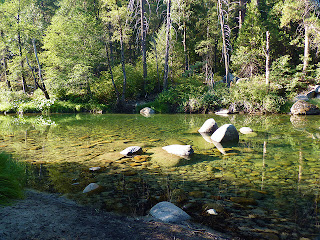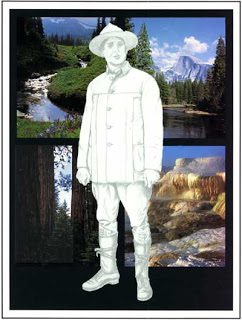Come meet a true Yosemite insider! Peter Hoss, author of Born in Yosemite: 75 Years of Personal Observations will be doing a book signing on August 30 from 3:00-5:00 PM at the Valley Visitor Center and August 31 from 3:00-5:00 PM at the Wawona Visitor Center. (National Park Service)
Born in Yosemite Valley in 1934, Peter takes the reader on a 75-year journey through historical events and personal adventures that shaped his Yosemite experience. His various relationships with Yosemite include child resident, employee, legal counsel, hiker, skier, and privileged visitor with firm belief in the conservation of Yosemite for future generations. (Yosemite Conservancy)
Purchase your copy from the Yosemite Conservancy Online Store.
By Mary Forgione
Los Angeles Times Daily Travel & Deal blogger
August 24, 2012, 6:45 a.m.
The National Park Service, the agency that overseas 397 national parks, battlefields, monuments, historic sites, seashores and even scenic byways, turns 96 on Saturday.Some parks are older than that — Yellowstone, the nation’s oldest park, was created in 1872 — and some are much younger. Gates of the Arctic National Park and Preserve, for example, is little known even though it stretches 8.4 million acres in Alaska’s Brooks Range. It became a national park and preserve in 1980. Or the lush National Park of American Samoa, which was designated parkland in 1988.
In honor of the Park Service milestone, Yosemite National Park will be holding presentations on search and rescue, fire management and science, and other aspects of park management from 9 to 11 a.m. Saturday at the Yosemite Visitor Center in Yosemite Valley. Also, an 8 p.m. program will discuss the history of the Park Service at LeConte Memorial Lodge.
Hawaii Volcanoes National Park on the island of Hawaii also will turn 96 on Saturday. The park is set to celebrate the U.S. Mint release of quarters bearing an image of the park. The quarter will make its debut at the park during ceremonies from 1 to 3:30 p.m. Wednesday.
And Rocky Mountain National Park in Colorado will be hosting a sixth BioBlitz, an event that will be held every year leading up to the Park Service centennial in 2016. On Friday and Saturday, teams of experts and novices will comb the park to document as many species as possible in a 24-hour period. An accompanying Biodiversity Festival takes place from 9 a.m. to 5 p.m. both days at Estes Park Fairgrounds.
Copyright © 2012, Los Angeles Times

Bears have been active in Yosemite Valley in meadows, parking lots, and campgrounds. Bears have also been active in the White Wolf area along Tioga Rd. Make sure to always be within arm’s reach of food and scented items while in picnic areas and campgrounds. Several incidents have occurred because visitors were too far from these items. Please report all bear incidents and sightings to a ranger or the Bear Hotline.
Thirteen bears have been hit by vehicles so far this year. Four bears were hit in one week at the end of July along Tioga, Glacier Point, and Wawona Roads. Of the thirteen that were hit, four were confirmed to be dead. Please obey speed limits and scan roadsides while driving to ensure the safety of bears and other wildlife.
Interesting Bear Fact: The omnivorous diet of the black bear consists mainly of vegetation despite being classified in the Order Carnivora. In the summer months however, black bears will occasionally seek another food source that is difficult to obtain: fawns of Mule deer. Fawns are difficult to find due to their lack of scent, but can provide valuable nutrition to black bears. Fawns and carrion are the two main sources of meat in the diet of the black bear.
If you see a bear during your visit please report it to the Save-A-Bear Hotline at 209-372-0322 (National Park Service – www.nps.gov/yose).
The opening date for low-elevation climbing areas has been modified from August 1 to July 15 based on robust monitoring and analysis of Peregrine Falcon nesting chronologies in Yosemite over a 32-year period (1981-2012).
Effective as of July 15, all Peregrine closures except Medlicott Dome are lifted, including Arch Rock Area, B.O.L.T. Wall, El Capitan Southwest Face, El Capitan Southeast Face, Glacier Point east side, Half Dome South Face, Kolana Rock, Middle Cathedral Rock, Rhombus Wall, The Rostrum, Wapama Cliff, and Yosemite Point.
Medlicott Dome in Tuolumne is the highest elevation Peregrine nest in the state of California. Whereas young have already successfully fledged from 11 lower elevation sites in Yosemite this year, this Tuolumne nest is about 5 weeks behind the rest. We are monitoring this nest closely and will promptly lift the closure as soon as the juveniles have fledged and left the cliff area. (NPS)
There will be presentations and exhibits about law enforcement, medical emergencies, search and rescue, structure and wild-land fires, and more. Participants include: Mariposa County Sheriff, California Highway Patrol, Yosemite Team Intercept, US Forest Service Law Enforcement, Sierra Ambulance, Yosemite Clinic, YOSAR, Yosemite Fire, Mountain Crisis Center, and more. This event is free and open to all.
 |
| South Fork of the Merced River |
Dear Wawona Community:
This winter and spring have been exceptionally mild with regard to rain and snowfall. To date, 2012 is set to go down as one of the 10 driest years on record for Yosemite National Park. Because of this, water levels measured in the rivers and streams are exceptionally low for June. In fact, current data shows that water levels on the South Fork Merced River, for example, are dropping quickly and there is no significant precipitation forecasted in the near future.
Without significant precipitation in the upcoming days and weeks, the Tuolumne and South Fork Merced Rivers will drop to levels where it will be necessary to implement water conservation plans for the residents and visitors to Tuolumne Meadows and Wawona. Water conservation measures are mandatory when flow rates drop below 6 cubic feet per second (CFS). As of June 22, the South Fork Merced River was measured at 17 CFS, and as the chart above shows, hydrologic modeling indicates that Wawona will need to implement conservation procedures in early July. Further, without significant rainfall, these levels will continue to drop and each river will likely reach critical levels by late July. Critical levels are reached when demand for water exceeds the supply which is at 2 CFS.
In order for Yosemite National Park to meet the domestic water needs of Wawona and Tuolumne Meadows, water from Yosemite Valley and the park’s South Entrance will need to be transported to the Wawona Water Treatment Plant daily. In Tuolumne Meadows, the water supply is augmented by drawing water from the main stem of the Tuolumne River. Historically, we have not had to implement water conservation efforts in Tuolumne Meadows, so we will all learn how successful our conservation measures actually work. What is important is that the amount of water to be transported and diverted will depend upon the success of the conservation efforts in each community.
Attentive conservation measures, therefore, are our best opportunity to ensure that water is available where needed for safety and health purposes, as well as protection of park resources. We ask that you consider your water consumption in the coming days and look for ways to conserve it. In the coming days and weeks, we will continue to share more information about the water levels and conservation practices.
We thank you for attention and support as we all address this important community and preservation issue. Through our combined efforts, we can work to maintain adequate domestic water while still preserving the ecosystems of Yosemite National Park.
Don Neubacher, Superintendent
 |
| Moderate Traffic |
Thursday: Sunny weather with continued mild temperatures are expected during this reporting period. A prescribed management fire is underway this week near the Big Oak Flat entrance. A chance of smoke on the road may affect visibility; short traffic delays are possible.
 |
| Moderate Traffic |
Friday: Sunny, cooler and clear weather continues throughout the week making this an exceptional time to visit Yosemite! Anticipate traffic volumes to increase as the weekend approaches. Arrive early to avoid late afternoon traffic. School is out for the summer – please drive carefully.
 |
| Heavy Traffic |
Saturday: Traffic volumes are expected to rapidly increase by mid-morning with heaviest volumes of traffic arriving between 10am and 2pm. By arriving before 9am you stand the best chance of avoiding heavy traffic and finding a parking spot. There is a possibility of traffic diversions for Valley roads during peak travel times over this weekend. Reminder: no fireworks of any kind are permitted in Yosemite.
 |
| Heavy Traffic |
Sunday: Traffic volumes are expected to rapidly increase by mid-morning with heaviest volumes of traffic arriving between 10am and 2pm. By arriving before 9am you stand the best chance of avoiding heavy traffic and finding a parking spot. There is a possibility of traffic diversions for Valley roads during peak travel times over this weekend. Reminder: no fireworks of any kind are permitted in Yosemite.
 |
| Moderate Traffic |
Monday: Holiday traffic with a chance of congestion is likely. Day and night road work will continue on Wawona Road and secondary roads around Wawona – expect short traffic delays.
 |
| Heavy Traffic |
Tuesday: Holiday traffic with a chance of congestion is likely. Day and night road work will continue on Wawona Road and secondary roads around Wawona – expect short traffic delays.
 |
| Heavy Traffic |
Wednesday: Holiday traffic with a chance of congestion is likely. Day and night road work will continue on Wawona Road and secondary roads around Wawona – expect short traffic delays.
TRAVEL RECOMMENDATIONS:
- Bring plenty of food and water for potential delays.
- Park your vehicle for the duration of your stay. Driving from site to site increases traffic congestion.
- Ride the free shuttle buses to enjoy Yosemite Valley most easily once parked.
- Consider arriving early and staying late, or visiting Yosemite during the week.
- Enjoy the entire Yosemite region–consider visiting the surrounding communities of Mariposa, Groveland, Lee Vining and Oakhurst.
- Ride a YARTS bus to enter the park on Hwy 140 from El Portal/Mariposa or Hwy 120 from Sonora/Groveland.
PLEASE BE AWARE:
- Congestion is greatest in Yosemite Valley and at Glacier Point. It is especially heavy on weekends.
- Parking lots are generally full by noon, and sometimes earlier.
- Vehicles on roadsides must use designated turnouts and pull off the road completely. Do not park on vegetation.
- After reaching the one-way road on the Yosemite Valley floor, the only route to avoid the areas of heaviest congestion is the left-hand turn labeled for Highways 140, 120, and 41.
- During heavy traffic days, it is possible that a park ranger may temporarily divert you away from Yosemite Valley at El Capitan crossover (east of Bridal Veil Fall).






